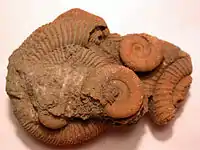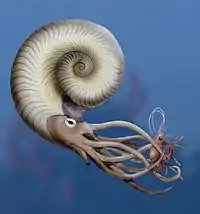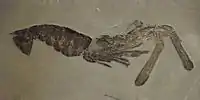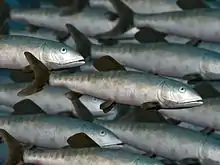Calcare di Sogno
The Calcare di Sogno ("Sogno Limestone"; also known as the Sogno Formation) is a geological formation in Italy, dated to roughly between 183-181 million years ago and covering the Toarcian stages of the Jurassic Period in the Mesozoic Era.[1] Thallatosuchian remains are known from the formation.
| Calcare di Sogno Stratigraphic range: Toarcian ~183–181 Ma | |
|---|---|
| Type | Geological formation |
| Underlies | Formazione delle Radiolariti |
| Overlies | Calcare di Domaro, Calcare di Morbio, Unnamed limestones[note 1] |
| Thickness | Typically 120–140 m (390–460 ft) East and west 70–100 m (230–330 ft) |
| Lithology | |
| Primary | Marl, marly limestone & abundance of clay Secondary: Alternation of marly limestones and marls, presence of graded Chalcudites |
| Other | Limestones with nodules of flint & subordinate marls |
| Location | |
| Coordinates | 45.8°N 9.3°E |
| Approximate paleocoordinates | 33.4°N 18.9°E |
| Region | Lecco Province |
| Country | |
| Type section | |
| Named for | Sogno |
| Named by | Gaetani & Poliani |
 Calcare di Sogno (Italy)  Calcare di Sogno (Lombardy) | |
Description
The formation is characterized by a disposition of regional deposition equivalent to the German Posidonia Shale, with a benthonic setting and deposition trends, mostly populated by marine fauna.[2] The environment of the formation was related to a marginal marine deposit, with probably epicontinetal deposition from near land environments, being connected to the central European seas of the Toarcian.[3][4][5]
Fossil content
Flora
Several plant leaves and fragments of wood wheren´t identified.[6]
| Genus | Species | Stratigraphic position | Material | Notes | Images |
|---|---|---|---|---|---|
|
|
Leaves |
Affinities with the Ginkgoaceae. Arboreal plants related to the modern Ginkgo species. |
| |
|
|
Leaves |
Affinities with the Araucariaceae. Arbustive to arboreal plants with several leaf morphotypes, probably from nearshore environments. |
| |
Molluscs
| Genus | Species | Stratigraphic position | Material | Notes | Images |
|---|---|---|---|---|---|
| Hildaites[1][2] | Hildaites sp. |
|
Especimens |
| |
|
Cornaptychus lythensis |
|
Especimens |
An indeterminate ammonite. Some of the specimens found are very fragmentary, making its identification complex.[2] |
| |
|
Dactylioceras polymorphus |
|
Especimens |
Type member Dactylioceratinae family of Ammonites. A common mediterranean genera, found on deposits along all europe. |
| |
|
|
Especimens |
|||
|
Harpoceras sp. |
|
Especimens |
Type reprensentative genus of the Harpoceratinae ammonite family |
| |
|
Collina gemma |
|
Especimens |
A Dactylioceratidae ammonite. Present and abundant on the Mediterranean Toarcian realm. |
||
Arthropods
| Genus | Species | Stratigraphic position | Material | Notes | Images |
|---|---|---|---|---|---|
|
Proeryon hartmanni |
|
Various specimens |
A Erymidae Decapodan Crustacean common on the mediterranean rocks. Frequent presence of Burrows Thalassinoides with fossilised specimens nearby. A complete Seafloor section was fossilized. |
| |
|
Gabaleryon[8] |
Gabaleryon garassinoi |
|
Various specimens |
A Coleiidae Decapodan. Was confussed with Proeryon hartmanni specimens. |
|
|
?Antrimpos sp. |
|
Single specimen |
| ||
|
?Etallonia[8] |
?Etallonia sp. |
|
Single specimen |
| |
|
Archaeopalinurus[7] |
Archaeopalinurus cfr. A. levis |
|
Various specimens |
A Palinuroidean Decapodan. |
|
|
Uncina[9] |
Uncina alpina |
|
Various Specimens |
An Astacidean Decapodan of the family Uncinidae. A large decapodan, with sizes up to 40 cm. |
|
Fish
| Genus | Species | Stratigraphic position | Material | Notes | Images |
|---|---|---|---|---|---|
|
Monte Cornizzolo |
Several Especimens |
Type member of the family Pholidophoridae inside Pachycormiformes. A small sized fish, mostly related to marine deposits, associated with various predatory behaviours, including coeloids and Crocodrylomorphs. |
| |
|
Monte Cornizzolo |
+100 specimens |
Type member of the family Leptolepidae inside Leptolepiformes. It is the most abundant fish found on the formation. |
| |
|
Monte Cornizzolo |
Several Especimens |
The main member of the family Pachycormidae inside Pachycormiformes. Large sized fish, able to reach near 1.4 m long. |
| |
Crocodyliformes
| Genus | Species | Location | Material | Notes | Images |
|---|---|---|---|---|---|
|
cf. Pelagosaurus sp. |
|
Various specimens MSNM V4012, MSNM V4013. |
A Thalattosuchian marine crocodrylomorph of the family Teleosauridae.The specimens found where of small size, with several characters such as opened neurocentral vertebral sutures and non sutured caudal pleurapophyses, that led to expeculate a possible juvenile or subadult status. |
| |
See also
- List of fossiliferous stratigraphic units in Italy
- Toarcian turnover
- Toarcian formations
- Marne di Monte Serrone, Italy
- Sachrang Formation, Austria
- Posidonia Shale, Lagerstätte in Germany
- Irlbach Sandstone, Germany
- Ciechocinek Formation, Germany and Poland
- Krempachy Marl Formation, Poland and Slovakia
- Djupadal Formation, Central Skane
- Lava Formation, Lithuania
- Azilal Group, North Africa
- Whitby Mudstone, England
- Fernie Formation, Alberta and British Columbia
- Whiteaves Formation, British Columbia
- Navajo Sandstone, Utah
- Los Molles Formation, Argentina
- Mawson Formation, Antarctica
- Kandreho Formation, Madagascar
- Kota Formation, India
- Cattamarra Coal Measures, Australia
Notes and references
Notes
- Bioturbed hazel-gray limestones in planar layers of about 20 cm, with concentration of gray flint and gray & reddish marls, along with calcareous marl.[1]
References
- CARTA GEOLOGICA D’ITALIA 1:50.000 - CATALOGO DELLE FORMAZIONE. Formazione di Sogno.SERVIZIO GEOLOGICO - CONSIGLIO NAZIONALE DELLE RICERCHE - COMMISSIONE ITALIANA DI STRATIGRAFIA: http://www.isprambiente.gov.it/files/pubblicazioni/periodicitecnici/quaderni-sgi/quad7/form5.pdf
- GAETANI M. & POLIANI G. (1978) - Il Toarciano ed il Giurassico medio in Albenza (Bergamo). Riv. It. Pal. Strat., 84 (2): 349-382, 5 figg., 2 tavv., Milano.
- GAETANI M. & ERBA E. (1990) - Il Bacino Lombardo: un sistema paleo alto/fossa in un margine continentale passivo durante il Giurassico. In: JADOUL F. & MASSIOTTA P. (Eds.): «La geologia italiana degli anni ’90 - Guida alle escursioni pre-congresso». 75° Congr. Naz. Soc. Geol. It.: Escursione A3, pp. 23, 14 figg., 1 tav., Milano
- DEL SERE M. (1966) - «Lagenidea» del Lias dell’Albenza (Bergamo). Riv. It. Pal. Strat., 72 (1): 147-188, 2 figg.,4 tavv., Milano.
- BERSEZIO R., JADOUL F. & CHINAGLIA N. (1997) - Geological map of the Norian-Jurassic succession of Southern Alps north of Bergamo: explanatory notes. Boll. Soc. Geol. It., 116 (2): 363-378, 1 carta geol., Roma
- A. Tintori. 1977. Toarcian fishes from the Lombardian basin. Bolletino della Società Paleontologica Italiana 16:143-152
- Garassino, A., & Gironi, B. (2005). Proeryon hartmanni (v. Meyer, 1835)(Crustacea, Decapoda, Eryonoidea) and Archaeopalinurus cfr. A. levis Pinna, 1974 (Crustacea, Decapoda, Palinuroidea) from the Lower Jurassic (Toarcian) of Cesana Brianza-Suello (Lecco, N Italy). Atti della Società italiana di Scienze naturali e del Museo civico di Storia naturale in Milano, 146(1), 53-68.
- Audo, D., Williams, M., Charbonnier, S., & Schweigert, G. (2017). Gabaleryon, a new genus of widespread early Toarcian polychelidan lobsters. Journal of Systematic Palaeontology, 15(3), 205-222.
- Schweigert, G., Garassino, A., Hall, R. L., Hauff, R. B. & Karasawa, H. 2003. The lobster genus Uncina Quenstedt, 1851 (Crustacea: Decapoda: Astacidea: Uncinidae) from the Lower Jurassic. Stuttgarter Beiträge zur Naturkunde, Serie B, 332, 1-43
- M. Delfino and C. Dal Sasso. 2006. Marine reptiles (Thalattosuchia) from the Early Jurassic of Lombardy (northern Italy). Geobios 39:346-354
Bibliography
- Weishampel, David B.; Peter Dodson, and Halszka Osmólska (eds.). 2004. The Dinosauria, 2nd edition, 1–880. Berkeley: University of California Press. Accessed 2019-02-21. ISBN 0-520-24209-2














